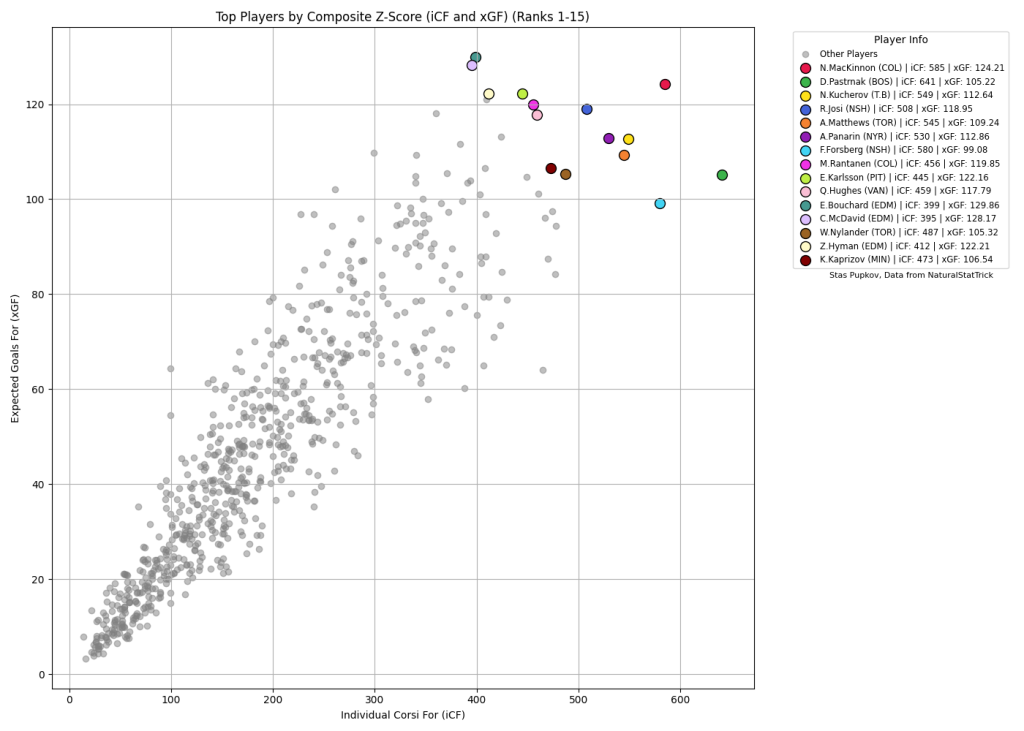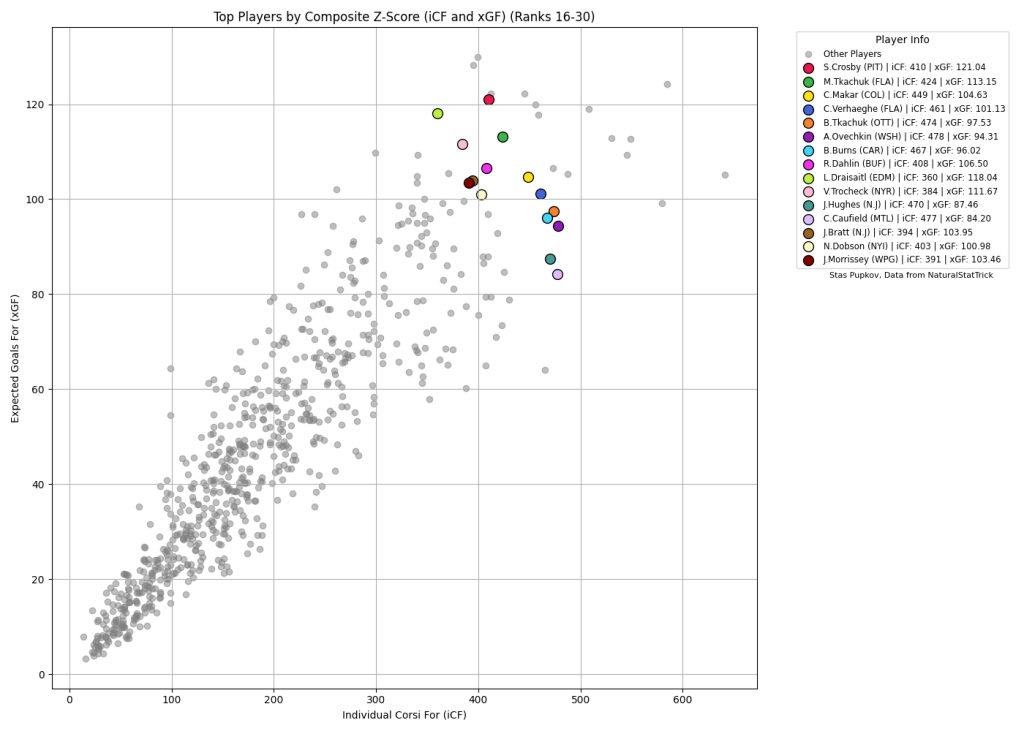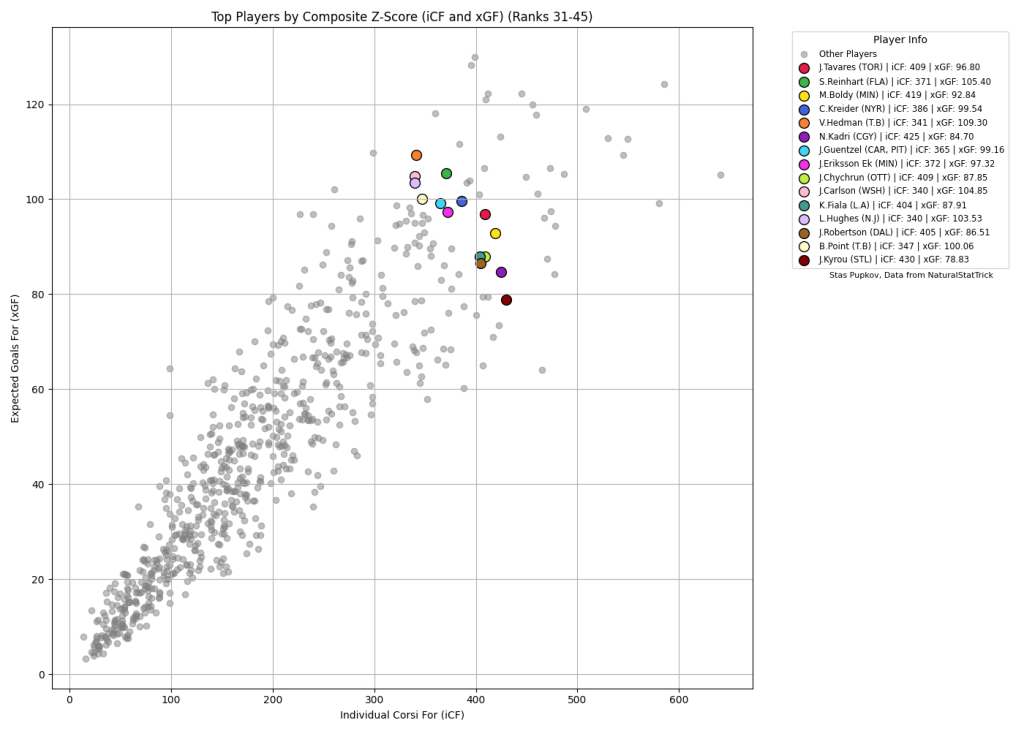Analytics Advantage: Individual Shot Attempts, Expected Goals, and Efficiency
Stas Pupkov
2024-03-22
The evaluation of player performance in fantasy hockey is evolving, with advanced metrics providing a deeper understanding of a player’s impact beyond traditional statistics. Among these, Individual Corsi For (iCF) and Expected Goals For (xGF) have emerged as crucial indicators for assessing offensive contributions and efficiency. This analysis aims to compare iCF and xGF to explore their relevance and application in fantasy hockey, offering insights into their utility for identifying valuable players.
Data Overview
The analysis utilizes NHL player data focusing on skaters, encompassing recent complete seasons to ensure a comprehensive evaluation. The key metrics of interest, iCF and xGF, are derived from shot attempt data and shot quality assessments, respectively. iCF counts all shot attempts made by a player, serving as a proxy for offensive engagement, while xGF estimates the expected goals from those attempts, accounting for factors like shot location and type. This dataset includes players who have participated in a significant number of games to mitigate the impact of short-term fluctuations and ensure the reliability of the metrics.
Methodology
In this analysis, we focus on NHL skaters who have participated in at least 15 games in the season and have accumulated a minimum of 150 minutes of total on-ice time. This selection criterion ensures that our dataset captures players with significant playing time and contribution to their teams, providing a reliable basis for comparing iCF (Individual Corsi For) and xGF (Expected Goals For) metrics.
To facilitate a direct comparison of player performance across these metrics, we employ z-scores to normalize the data. Z-scores are calculated for both iCF and xGF for each player, reflecting how their performance deviates from the league average in terms of standard deviations. This normalization process allows us to rank players in a standardized manner, identifying those who stand out in either metric relative to their peers.
Analysis Insights
High Performers (Rank 1-15): At the pinnacle, players who excel in both iCF and xGF metrics often align with household names in fantasy hockey. Their ability to generate a high volume of shot attempts and convert these into quality scoring chances underscores their fantasy relevance and real-world impact.

Efficient Contributors (Rank 16-30): The analysis highlights players with notable xGF despite having average iCF counts. Such players, efficient in converting their attempts into expected goals, emerge as potentially undervalued in fantasy drafts. Their knack for quality over quantity makes them strategic picks for savvy managers.

Volume vs. Quality (Rank 31-45): Players characterized by high iCF but modest xGF metrics underscore the distinction between volume shooters and efficient scorers. While these players are instrumental in driving the offensive play, their lower conversion efficiency into quality chances could impact fantasy point maximization.

Role Considerations: Differentiating performance between forwards and defensemen reveals expected trends—defensemen generally register lower xGF due to shot types and origins. This nuance stresses the importance of role-specific analysis in evaluating fantasy value.
Strategic Fantasy Implications: The findings advocate for a balanced approach in fantasy roster construction, blending players who excel in shot volume with those distinguished by shot quality. Particularly, spotlighting players with high xGF offers a pathway to identifying sleeper picks that could outperform their draft position.
Conclusion
The examination of Individual Corsi For (iCF) and Expected Goals For (xGF) within the realm of fantasy hockey sheds light on the multifaceted nature of player performance and its implications for fantasy league success. By focusing on these metrics, fantasy managers can gain insights into not just the quantity of a player’s offensive contributions but also the quality of those efforts. This analysis underscores the importance of looking beyond traditional statistics to understand the full scope of a player’s impact on the ice.
Players with high iCF totals demonstrate a propensity for generating offensive opportunities, making them valuable in fantasy formats that reward shots on goal and overall offensive engagement. On the other hand, those excelling in xGF are efficient in their play, often contributing to high-quality scoring chances that are more likely to result in goals. Such efficiency is particularly valuable in leagues that prioritize goal scoring and shot quality.
Incorporating these advanced metrics into fantasy hockey strategy allows managers to identify undervalued players, optimize draft and trade decisions, and make informed roster management choices. Whether it’s uncovering sleeper picks poised for a breakout or balancing a roster with a mix of volume shooters and efficient scorers, the insights from iCF and xGF analysis provide a strategic edge.
Thank you for reading and have a great rest of your day!
Twitter/X – @DH_staspup for any questions, corrections, or comments
If you want to see how your team looks on the graph, DM me a list/photo of your roster
Player Data sourced from NaturalStatTrick




 NYI
NYI CAR
CAR T.B
T.B FLA
FLA TOR
TOR BOS
BOS VGK
VGK DAL
DAL EDM
EDM WSH
WSH L.A
L.A COL
COL VAN
VAN WPG
WPG NYR
NYR NSH
NSH ANA
ANA
